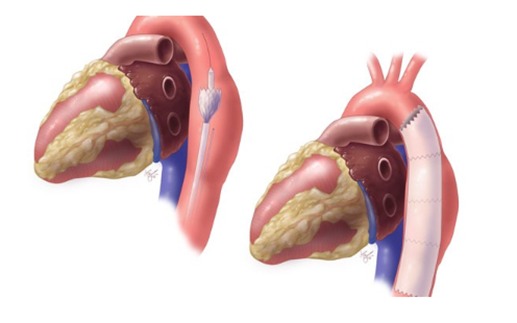DISSECTION
An aortic dissection is a serious condition in which a tear occurs in the inner layer of the body’s main artery (aorta). Blood rushes through the tear, causing the inner and middle layers of the aorta to split (dissect). If the blood goes through the outside aortic wall, aortic dissection is often deadly.
Aortic dissection is relatively uncommon. It usually occurs in men in their 60s and 70s. Symptoms of aortic dissection may mimic those of other diseases, often leading to delays in diagnosis. However, when an aortic dissection is detected early and treated promptly, the chance of survival greatly improves.
Symptoms
Aortic dissection symptoms may be similar to those of other heart problems, such as a heart attack. Typical signs and symptoms include:
- Sudden severe chest or upper back pain, often described as a tearing or ripping sensation, that spreads to the neck or down the back
- Sudden severe stomach pain
- Loss of consciousness
- Shortness of breath
- Symptoms similar to those of a stroke, including sudden vision problems, difficulty speaking, and weakness or loss of movement (paralysis) on one side of your body
- Weak pulse in one arm or thigh compared with the other
- Leg pain
- Difficulty walking
Causes
An aortic dissection is caused by a weakened area of the aorta’s wall.
Aortic dissections are divided into two groups, depending on which part of the aorta is affected:
- Type A. This more common and dangerous type involves a tear in the part of the aorta where it exits the heart. The tear may also occur in the upper aorta (ascending aorta), which may extend into the abdomen.
- Type B. This type involves a tear in the lower aorta only (descending aorta), which may also extend into the abdomen.
Treatment
An aortic dissection is a medical emergency requiring immediate treatment. Treatment may include surgery or medications, depending on the area of the aorta involved.
- Surgery. Surgeons remove as much of the dissected aorta as possible and stop blood from leaking into the aortic wall. A synthetic tube (graft) is used to reconstruct the aorta. If the aortic valve leaks as a result of the damaged aorta, it may be replaced at the same time. The new valve is placed within the graft.
- Medications. Medications are given to reduce heart rate and lower blood pressure, which can prevent the aortic dissection from worsening. They may be given to people with type A aortic dissection to control blood pressure before surgery.
